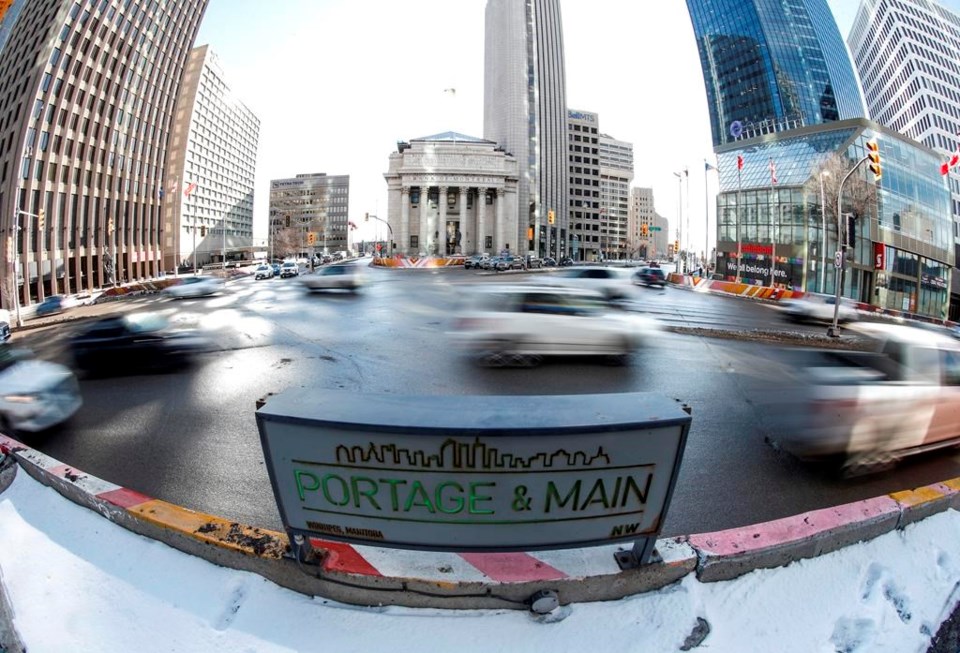WINNIPEG — The landmark intersection of Portage Ave. and Main St., which has inspired a song, a stamp, and years of passionate debate among Winnipeg residents, may soon be open to pedestrians for the first time in more than 40 years.
Mayor Scott Gillingham, who was against the reopening of the downtown junction in the last election campaign, said Friday he now wants it reopened to foot traffic by the summer of 2025, after receiving a report on the cost of needed repairs.
"With that in mind, I cannot support the status quo," Gillingham said Friday.
"We need to pursue a more practical alternative. It's time to open Portage and Main to pedestrian traffic."
The intersection holds a special place in Winnipeg hearts.
It was where the city’s first business was set up outside a fort to the south, becoming the centre of Winnipeg as it grew to become the gateway to the West a century ago.
People have congregated by the thousands at the intersection to celebrate milestones — from the end of war to the return of the National Hockey League.
The intersection has also appeared on a stamp and was featured in the song "Prairie Town" by rocker Randy Bachman.
It was open to pedestrians until 1979, when developers agreed to build an adjacent office tower and underground mall on the condition the city force pedestrians below street level.
Ever since, large concrete barriers have prevented people from crossing, guiding them to an underground circular concourse that can leave visitors confused. Its series of hidden, narrow stairway entrances and not-always-functional elevators have also raised concerns about accessibility for people with mobility issues.
Supporters of the barricades have said the no-pedestrian zone reduces accidents, prevents downtown traffic snarls, and gives people a climate-controlled place to stroll and shop in Manitoba's blustery winters.
In a 2018 non-binding plebiscite called by former mayor Brian Bowman, 65 per cent of voters opted for keeping the barriers up. Gillingham, who won the next election in 2022, said he would respect the results.
His change of heart follows a city study that says carrying out repairs at the intersection while maintaining the underground walkway would cost $73 million and disrupt traffic for up to five years.
Much of the work would involve repairing a leaky membrane that prevents the underground from flooding. Drips are often noticeable after rainstorms.
Gillingham says the work could be less expensive and disruptive if the underground concourse was closed and the intersection opened to pedestrians.
The final decision will be up to city council, which is divided on the issue.
The passion with which Winnipeg residents debate the intersection was evident at Friday's news conference.
Gillingham was supported by four council members at the announcement, but another council member, Russ Wyatt, leapt to the podium immediately after Gillingham ended his comments to denounce the mayor's plan.
The sound feed from the podium was quickly cut off as Wyatt demanded the city ask voters again for their approval.
"Have the courage and the wisdom to have another plebiscite. Don't have the arrogance to say that you're better than the people," Wyatt said.
Another councillor, Jeff Browaty, said he would be in favour of allowing pedestrian crossings on evenings and weekends. But he said the city hasn't fully examined the cost of decommissioning the underground.
"We don't know what the actual costs are to do the mothballing," Browaty said.
Loren Remillard, president of the Winnipeg Chamber of Commerce, said he supports opening the intersection and expects a better downtown once there are more feet on the street.
Remillard also said it's time to make a final decision on the junction and move on, so that the city can focus on other topics.
"Do we not have bigger issues in this city than a fight over whether to keep concrete barricades?"
This report by The Canadian Press was first published March 1, 2024.
Steve Lambert, The Canadian Press




